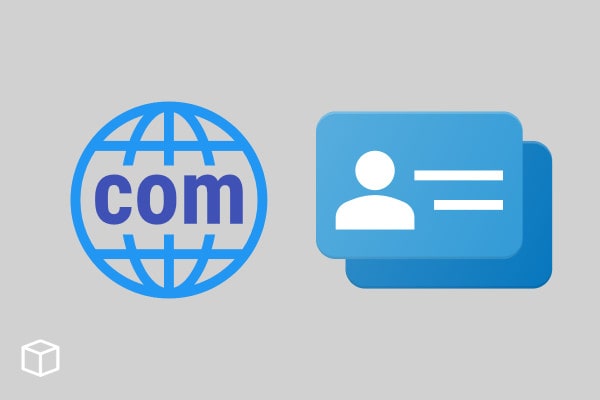A domain name is a unique web address, allowing you to find your site on the internet.
In this article, we will look at domain name in detail and will try to answer all your questions with domain in general
Let’s get started!
What is a Domain Name
A domain name is the identifier for a website. For example, the URL “https://www.google.com” tells you what company owns this site and where it can be found on the Internet.
By purchasing a domain, individuals or companies have an exclusive right to use that domain to promote their websites or business.

Anyone can buy a domain name. There are dozens of Domain Name Servers (DNS) where you can register your own domain names. Each DNS is in charge of certain top-level domains, for example .com, .net or the new top-level domain .xxx. You should check with your chosen DNS if they are accepting new registrations for the top-level domain you’re interested in.
While anyone can buy a domain name, there are restrictions on what terms can be registered. These vary from country to country and each registry maintains their own list of restricted or banned domains.
Before buying a domain name make sure you know who is selling it and whether they have the right to do so. You may want to ask for their terms and conditions of sale or check with your local registry.
Where do Domain Names come from?
Domains come from a DNS database, which is a directory of IP addresses.
The IP address points to a domain name, which points to a server with a website. When you type in a domain name, the DNS server looks up the corresponding address that hosts the site you’re visiting and takes you there.
DNS is the internet’s phone book, but you don’t have to pay anyone for its services.
How do new domains get released?
New domains are initially delegated to the registry company, or their partner gTLD registries for release into the root zone.
After the registry has released the names, they are available for registration to anyone.
What is the difference between a domain name and a website?
A domain name is a web address that ends in “.com” or “.org” and directs the carrier to the appropriate site.
A website is an online venue where one can go to find information. You may use your cellphone, tablet or computer to visit online venues that provide news, job searches, classified ads for buying and selling products, browsing product information on e-commerce sites like Amazon.com.
Different types of Domain Names
There are different types of domain names. The list is provided below:
1. Top-Level Domains (TLDs)
A TLD is a domain name extension that is operated by the Internet Corporation for Assigned Names and Numbers (ICANN).
The most common top-level domains are: .com, .edu, .gov, .info, .mil.

2. Country code top-level domains (ccTLD)
A ccTLD is a country code top-level domain used in the Domain Name System of the Internet.
ccTLDs, in a way, link a specific country or territory to the Internet. Some of these regions may be based on traditional geographical boundaries or geopolitical entities (ex: .uk for the United Kingdom), while others have little meaning other than serving as a technical distinction for country-coded top-level domains (.de for Germany, .ru for Russia).
A ccTLD may be granted to any country, territory, or geographic area on earth.
3. Generic top-level domains (gTLD)
Generic top-level domains are often called gTLDs. These are the most widely used top-level domains on the internet.
This type of domain is intended to be used by anyone for any purpose. Some examples of these are .edu, .gov, and .jobs.
Generic TLDs can be registered through many different registrars with varying costs per year or registration fees depending on the registrar.
How do domain names work?
It’s possible to have a domain name with any combination of letters, numbers and characters. It is always associated with a particular internet service provider.
A domain name has two important functions: it gives a web address a recognizable name that won’t change each time the company leasing the domain moves ISPs, and it also provides Internet users an easy-to-remember entry point for accessing the website – people can type in “google.com” without having to figure out that its IP address is 216.58.216.192.
Some domains are restricted on who can use them (such as “.edu” for educational institutions) while others are unrestricted (such as “.com”).
Domain names usually work by associating your site with some computing resources controlled by your name provider.
The way domain names work is that you pay an Internet service provider (ISP) who owns the server where all of your website files are stored, and it gives you a different address (e.g., www.test-software-way.com) for each web page on your site, connecting them all together so that visitors can navigate from page to page.
This is called a “domain name service” – the ISP uses the different addresses to keep track of your site’s contents and make it easier for people to find your site over the Internet.
If you don’t want to use an ISP, you can also buy server space somewhere else and buy a domain name from a third party.
Which is an example of a domain name?
www.facebook.com is an example of a domain name.
When were domains first created?
The first domain name was created in 1985.
Users were only able to register an email address for a period of time. The user would also have to wait for approval to be granted before they were able to make any use of the email address.
Now, it is possible for users to purchase and sell domains without any form of pre-approval.
Domain Name Structure Explained?
Domain Name Structure, which is also called DNS, is the hierarchical naming system for computers, services, or any resource connected to the internet or a private network.
It’s in charge of directing traffic accordingly. For example, when you type “google.com” in your web browser, it sends you to the correct server that has that domain name.
What are some the most expensive domain names?
As per GoDaddy these are some of the most expensive domain names:
- CarInsurance.com — $49.7 million.
- Insurance.com — $35.6 million.
- VacationRentals.com — $35 million.
- PrivateJet.com — $30.18 million.
- Voice.com — $30 million.
- Internet.com — $18 million.
- 360.com — $17 million.
- Insure.com — $16 million
Who controls the domain name system?
The domain name system is controlled by ICANN (Internet Corporation for Assigned Names and Numbers (ICANN)). It is an American company, based in California.
Every domain name on the internet has a record in their database.
When you request a webpage from your browser, it asks ICANN which server the website is hosted on and then connects to that server.
How to choose a domain name?
There are a lot of different ways to pick a domain name.
The first thing you want to do is brainstorm some word combinations and see what words fit the subject matter you’re thinking about.
It’s also a good idea to think of a name that has an easy spelling and is memorable so people can search for it on the internet.
Here are some additional tips to help you find a domain name:
1) Picking the name for your website is kind of like naming your baby. It’s one of those decisions that seems simple at first, but can really take time and consideration. You want to be happy with the choice for the rest of your life, not just until your website is finished.
2) Choosing a domain name is an important part of starting any new website. Your site’s URL is one of the first things that people will see on your site, so you want to make sure it looks professional and relates to the topic of your blog or business.
3) When deciding on a domain, think about what you want out of your website. If it’s for personal use, then you may want to go with something short and catchy.
4) If you are serious about blogging or making money online then choose a name that relates to your niche. Your blog or business will most likely be found by googling various words and phrases. Targeting a particular niche is crucial to your online success.
5) You don’t need to have all the details worked out before you register your domain name. You can always change it later, so don’t worry if you are not sure.
6) Keep in mind that other people might come up with the same or similar ideas for names as you do, so brainstorm a large variety of options.
7) Don’t just choose names based off of catchy phrases. Make sure that the domain name relates to your website’s content and purpose, so it will be easier for people to find you when they search on Google or Yahoo!
How to buy a domain name?
There are two steps to getting your domain name. The first, is that you need to find a domain name that has not already been taken.
You can do this by running a search on the site. If the domain is available, it will show up as having an account with someone’s domain name registrar (usually the company where you buy the domain).
After you’ve narrowed down which domains you want to look at, make sure they are still available before purchasing them (again, by checking the registrar site).
The second step is figuring out who your domain name registrar will be. This means finding out which companies offer this service and how much it will cost.
There are some services that offer free domains if you sign up for their hosting services, but usually the price will be under $10. Once you’ve broken down which domains you want to use and where they’ll be registered, purchase them!
The next step is contacting your new domain name registrar (e.g. Namecheap) and updating your nameservers with them so that your website will start working. You’ll usually be able to do this through their support section once you’ve signed in.
Can I buy multiple domains?
Yes, you can purchase as many domains as you want. I recommend registering only the domain names that you really care about to ensure that you have a good chance of retaining them.
Always remember that once you pay the registration fee, no one can take away your domain name. Once it’s yours, it’s yours for life (as long as you renew it every year).
What if my domain name expires?
If your domain name expires, you could have a big problem. Let’s say you have a website with a domain name that is expired and you want to keep it as your website.
You need to renew the domain name as soon as possible because any other person can now buy that domain from you.
If someone else buys the now-expired domain name, they now own it and have control over what the website displays on the webpage.
Not only will they be able to change what it says, but they may also sell your domain name to someone else. If that happens, you will have no say in what is displayed on the page.
How to Transfer a Domain Name
Transferring a domain name is different than changing the DNS.
If you are transferring your domain name, it means that you are moving it from one registrar to another.
It’s important to make sure that the current registrar has released ownership of your domain before transferring it. You should also make sure that the URL for your website is still accessible before proceeding with the transfer.
The first step is to login into your account with the current registrar. Often, they will provide you an option to release ownership of your domain when you try to transfer it.
The second step is contacting the desired registrar to initiate the transfer process by providing them with information about your domain and credentials for accessing your account with them.
You’ll need to provide the required information in order to complete the transfer.
Please note that you can’t cancel a domain transfer after it has been initiated, and it is possible for your desired registrar to reject your request, leaving your domain in its current name with no changes.
If this happens, you should contact their support team and try to resolve the issue.
If your domain expires, it can take up to 45 days before it is unlocked. During this time, you won’t be able to transfer your domain. It will automatically drop back into the pool of available domains and become available for anyone to register.
If you need more information about completing a transfer or other related issues, please contact their support team for assistance.
You Might Also Like
- What is Mobile Development and How to Learn it
- What is Proxy server and How does it work?
- What is Hadoop and How does Hadoop work?
- What is Django and How does it work?
- What is TensorFlow and How does it work?
- What is Scala and How does it work?
- What is GitHub and how does it work?
- What is Machine Learning and how does it work?
- What is Artificial Intelligence and how does it work?
- What is Open Source Software and how does it work?





